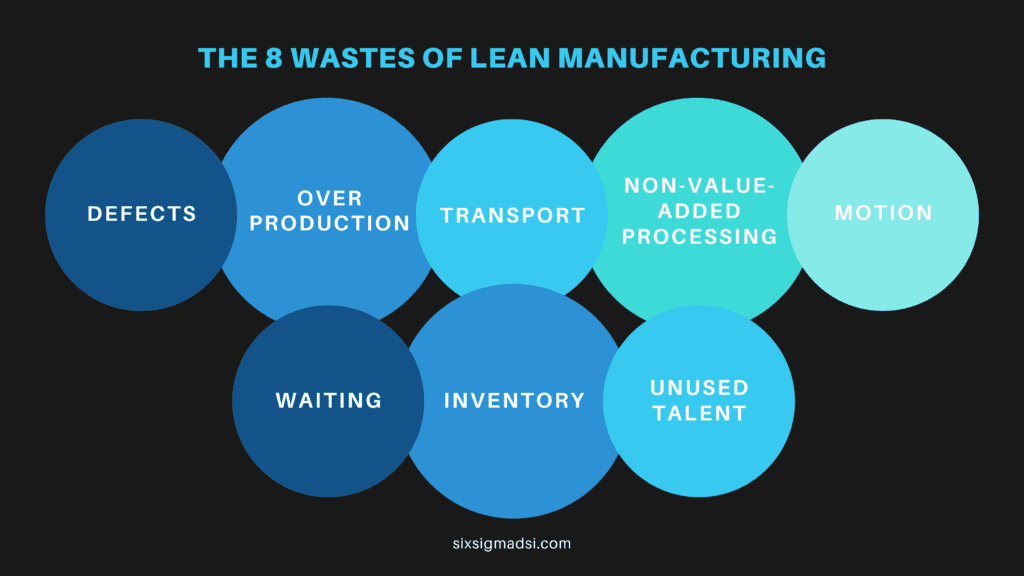Table of contents
Six Sigma: The 8 Types of Waste
Lean Six Sigma methodology is based on the elimination of waste. Lean Six Sigma consultants have developed a list that identifies the eight most common wastes to help companies solve them. These include defects, overproduction, and non-value-added processing.
Lean is successful when you understand these eight areas, and focus your process improvement efforts on each one. Lean differs from Six Sigma in that it focuses on eliminating errors and mistakes, however, when their combined Lean Six Sigma practices, their consultants combine both methodologies to help companies.
What Are The Eight Wastes?
Defects
Defects require the scrapping of the product and a new start. This is one of the worst possible wastes in terms of time, money, and materials. Lean is a system that focuses on customer satisfaction. A defect in Lean can be anything that doesn’t satisfy the customer.
Six Sigma was created to reduce the number of defects for companies with the help of its consultants. By using the popular DMAIC methodology (define measure analyze improve and control), it is easier to identify and eliminate defects from a process.
Overproduction
The success of a business can cause it to produce too many products and get ahead of the consumer demand. It also applies to the processes of the entire operation, like producing too many components before the workers in the downstream operation are ready for them. This can result in extra storage costs and other problems.
By paying better attention to The Voice of the Customer, and by understanding what their needs are, you can reduce overproduction. A complete production plan is needed to make sure that sub-processes are working together. This includes all the functions of each phase.
Transport
Poorly planned processes are often the cause of transportation problems. Transportation can be any part of the process that involves carrying tools and materials by hand or vehicle. This can also be used to describe the time taken to send the information needed to continue a particular process (such as approvals from management). The longer the route of transportation, the more time is wasted.
Value-Stream Mapping helps reduce inefficiencies by providing teams with a visual representation of each interlocked phase of a procedure, making it easy to identify areas that need changes.
Non-Value-Added Processing
A number of factors can cause actions to be taken that don’t add value to the process. These include typical signs of an unplanned process: poor communications, overlapped areas of responsibility, and duplication of data. It’s important to evaluate each step of a process to determine whether it adds any value to the customer.
Value Stream Mapping and tools like The 5 Whys can be helpful in this regard. These allow organizations to dig down into the underlying causes of operational problems.
Motion
A poorly designed process is one that requires employees to perform extra steps, whether they are physical or software-based. Wasting time costs money. This problem is often traced back to poorly designed workstations and workflow.
can eliminate wasteful motion by setting up efficient workstations and processes. Companies use the 5-S system to maintain an efficient and smart workstation.
Waiting
In a production process, waiting can take many forms. Workers are usually waiting for someone upstream to give them materials or information that they need in order to complete their tasks. Bottlenecks can lead to wasted time and wait. Waiting can also be caused by attending numerous meetings instead of getting the work done.
Another area where mapping a process will help to streamline production and eliminate the need for waiting in this area. A Fishbone diagram helps break down the entire operation into its component parts. This can help find small problems that can lead to bigger ones.
Inventory
Inventory problems can arise from the overproduction of finished goods or materials that must be stored. This can also be caused by ordering too many products from suppliers, requiring large quantities of storage space. Inventory waste is the money spent on warehouse space, which would have been avoided if the process was more efficient.
Overproduction and overprocessing are often used to address this issue.
Unused Talent
It is not about process, but instead, a company that does not use all of the talents at its disposal. Frontline workers, for example, often have a better understanding of the root causes of issues than their managers. They also have ideas about how to solve the problem. Every industry faces the challenge of unused talent. To eliminate this waste, managers must examine the skills and knowledge that their employees have and determine how they can be used to improve operations.

Why it’s Important to Remove Wastes in Lean Six Sigma
It is important to identify and eliminate waste from a project, as it could lead to a complete failure or a significant decrease in the value of the project. Even if the project is completed successfully, the profits will be lower if waste elimination is not taken into consideration.
Although it is difficult to eliminate all waste, hiring experts who have completed Green Belt training will prove beneficial. These experts are able to identify issues or waste types that can reduce the value of your project. They identify the triggers and create strategic plans for project success. You can be assured that six sigma waste reduction won’t be a problem if you choose the right experts for your companies.
Downtime is the most significant factor for consultants in Six Sigma waste and lean waste. This could be due to candidates not putting in their best effort or a team waiting on the other to finish a task before completing it. Companies try to find ways to reduce waste by substituting dead weight for something more productive. They also bring in the tools and techniques to enhance the project potential by eliminating waste factors. They do simple things to minimize downtime.
- Ensure that all company operations are carried out smoothly and seamlessly so that teams can work together without waiting.
- Assigning tasks that are relevant to the people involved, while keeping in mind their talents or abilities to avoid wasting resources.
- Eliminating downtime due to lack of resources or any other factor. People may have to wait until the management begins the meeting, or the higher authorities give them the resources they need.
- Organize your inventory and administrative tasks, and leave no stone unturned to achieve zero downtime.
Every organization has a variety of consultants with proven strategies and techniques for Six Sigma waste reduction. What happens when you don’t remove waste from your project or why do you need to remove it? Let’s dig deeper to discuss this.

8 Examples of Wastes
There are countless examples from companies for each of the 8 types of Six Sigma waste. We have categorized the real-life examples accordingly to help you understand them better.
1. Defects
Common defects you might face are misleading information on the charts or reports shared across the project team. Another example can be wrong labels on the containers or basically any other mistake that can lead to flawed actions.
2. Overproduction
Real-life examples of overproduction include printing unnecessary documents when you have the option to keep information on the computer system. Another option is to store the same information on multiple forms instead of segregating it into one.
3. Waiting
As the name suggests, waiting is when the client has to wait for the service delivery or if one team waits as the other sends information to start their work. Moreover, waiting is also when the team sits idle, waiting for the resources that the company has to provide.
4. Transportation
You can link it with moving assets unnecessarily from one place to another. It is also related to the event when one has to make too many mouse clicks on the website before getting the required information.
5. Inventory
Overstocking products even when you can do with much lesser quantity. Keeping unnecessary documents and files in the office cabinets is also an example of waste.
6. Unused Talent
Not assigning tasks as per talents is significant waste in an organization. Moreover, not organizing staff training to update the skills also leads to asset wastage.
7. Motion
Excessive staff movement to fetch things they require is a waste associated with time.
8. Extra Processing
Processing the same information over again is a waste of time, effort, and resources. Once you get satisfactory test results, move ahead and do not keep processing them.
These real-life scenarios would have given you an elaborate idea of what ‘waste’ refers to in any project. So, if you are a project manager or simply a person concerned with project efficiency, identify if you see any such waste around you and take necessary actions to eliminate its impact.
Have you applied the 8 wastes of Lean to your projects?
Share your experience in the comments down below.



















